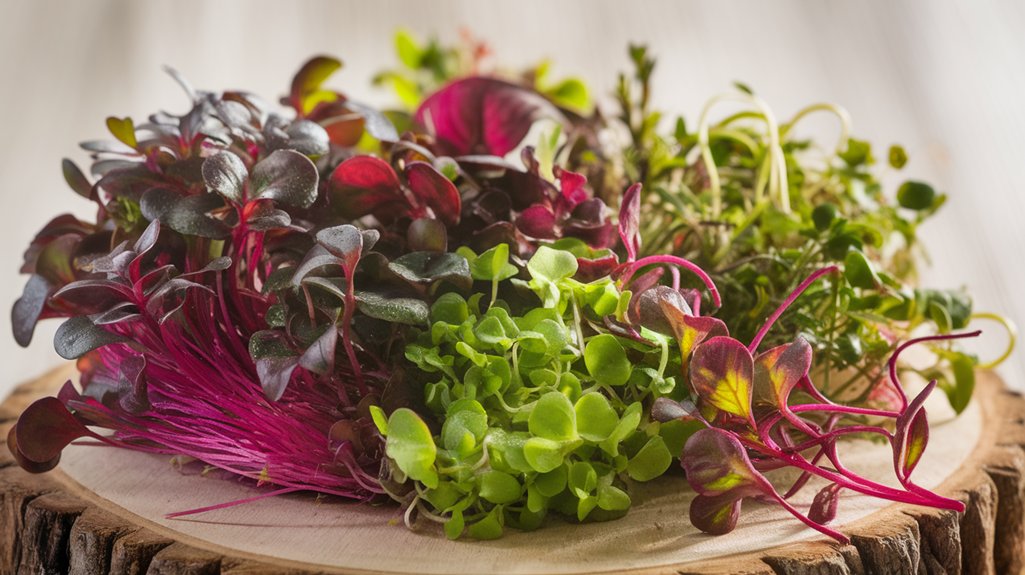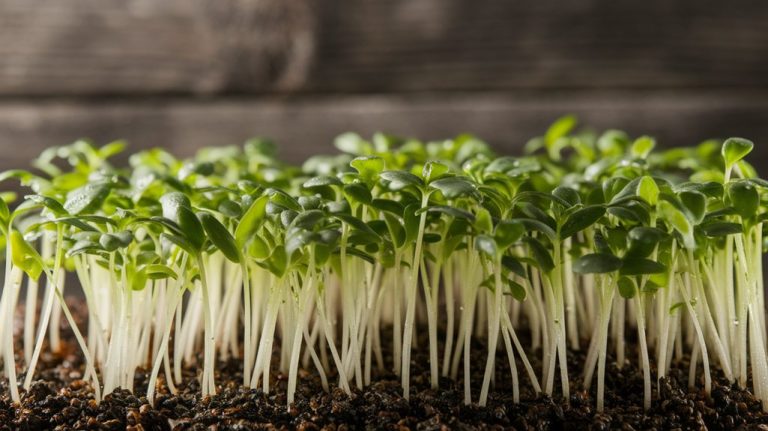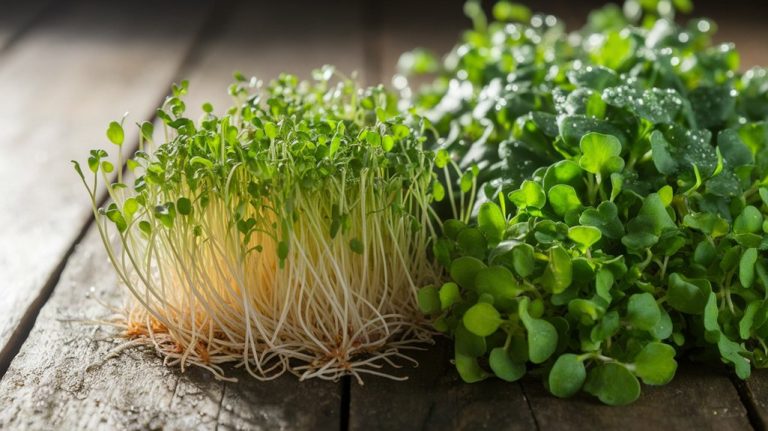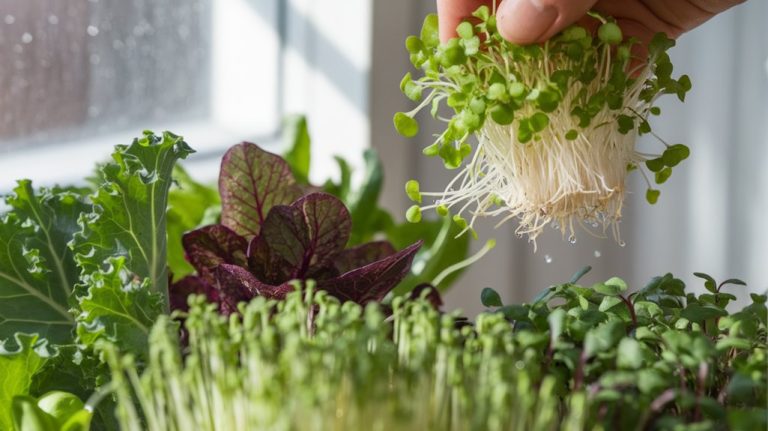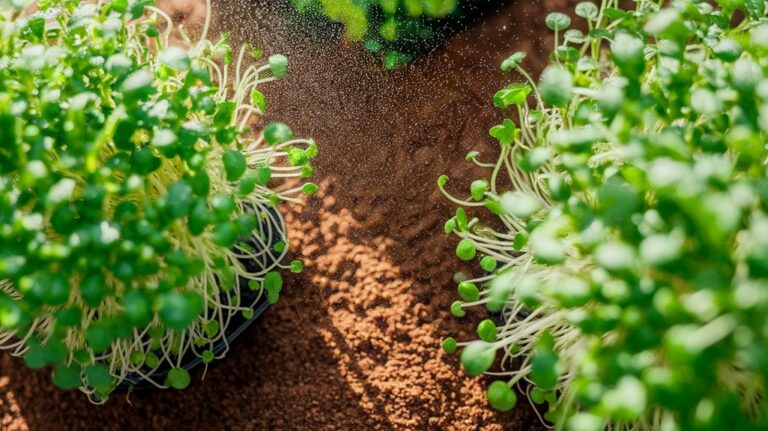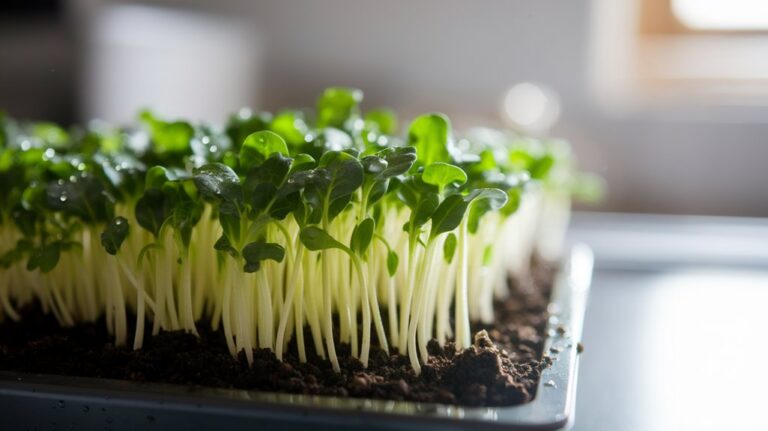Discover the World of Exotic Microgreens: Your Next Taste Adventure
When I discovered exotic microgreens, it felt like unlocking a vibrant world of flavors and nutrition. These tiny bursts of nature pack up to 40 times the nutrients of their mature counterparts, transforming everyday meals. Imagine the peppery kick of arugula or the subtle sweetness of pea shoots elevating your dishes. Plus, they’re easy to grow at home! Keep exploring this culinary adventure, and you’ll uncover more ways to enhance your meals with these delightful greens.
Key Takeaways
- Microgreens are nutrient-dense, offering up to 40 times the vitamins of mature plants, making them a healthy addition to meals.
- Popular varieties like arugula, basil, and sunflower add unique flavors and vibrant colors to salads, sandwiches, and other dishes.
- Pair microgreens with complementary ingredients to enhance both visual appeal and flavor, transforming ordinary meals into culinary masterpieces.
- Easy to grow at home, microgreens provide a fun and rewarding gardening project for enthusiasts of all ages.
- Sourcing exotic microgreens from local markets or online retailers can introduce unique flavors and enhance your culinary adventures.
What Are Microgreens?
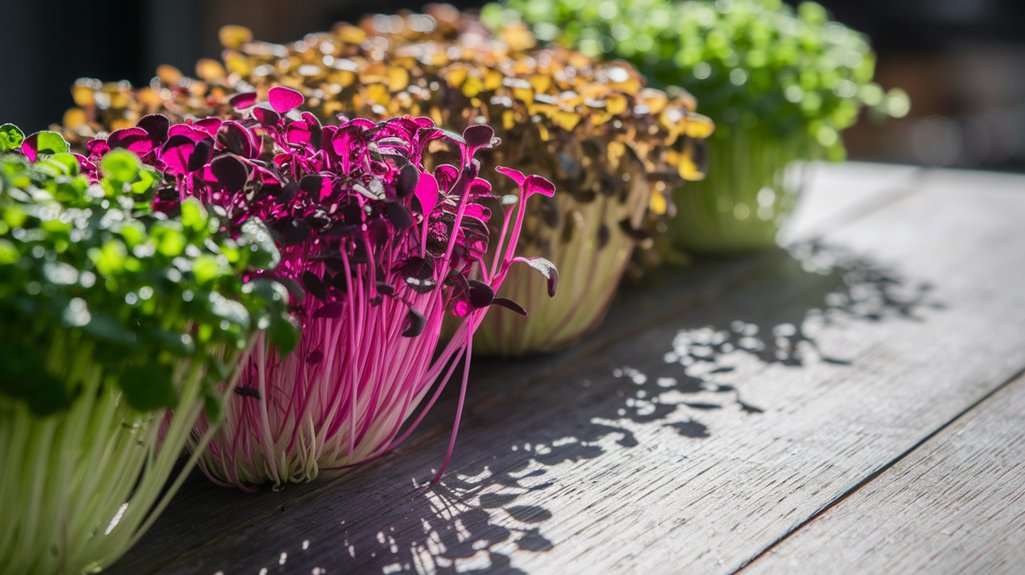
Microgreens are like tiny bursts of flavor and nutrition packed into delicate leaves and stems. These miniature greens spring from the seeds of various vegetables and herbs, and they’re usually harvested just after the first true leaves emerge.
I love how they add vibrancy to dishes, transforming a simple salad or sandwich into a culinary experience. From peppery arugula to sweet basil, each variety brings its unique taste and texture to the table.
They’re also incredibly easy to grow at home, making them a fun project for any food enthusiast. Whether sprinkled on a dish or blended into a smoothie, microgreens elevate meals with their vibrant colors and bold flavors, inviting us to explore their diverse world.
Nutritional Benefits of Exotic Microgreens
When it comes to nutrition, exotic microgreens pack a powerful punch that often surprises those who try them.
I’ve found that these tiny greens aren’t just about flavor; they’re brimming with benefits. Here are four reasons to embrace them:
- Nutrient Density: They can contain up to 40 times the vitamins and minerals of their mature counterparts.
- Antioxidants Galore: Many varieties are rich in antioxidants, helping to combat oxidative stress.
- Digestive Health: Their fiber content supports a healthy digestive system, making them a perfect addition to any meal.
- Low-Calorie Goodness: They add flavor without piling on calories, making them ideal for any diet.
Incorporating exotic microgreens into your meals is a delicious way to elevate your health!
Popular Varieties to Explore
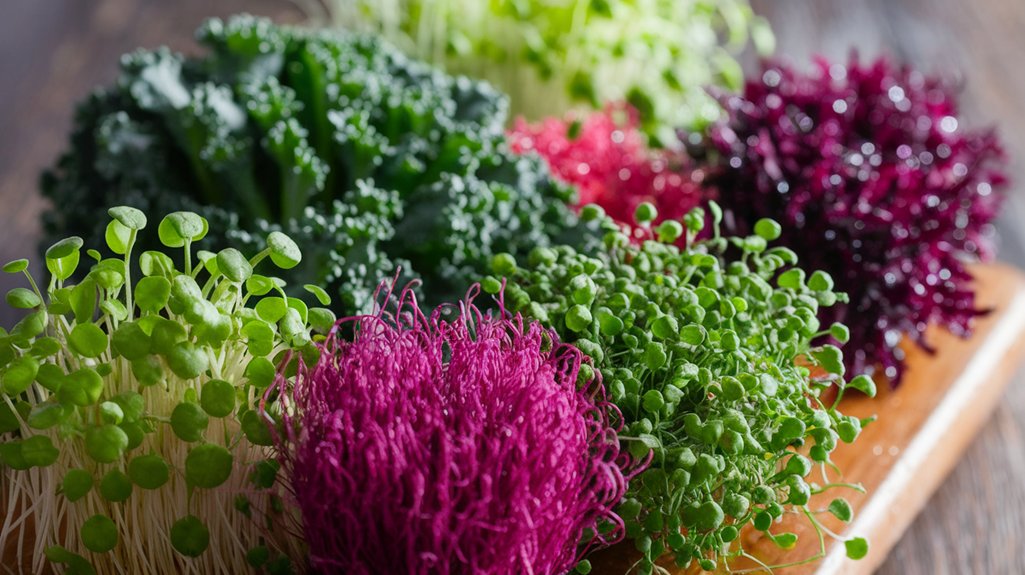
After discovering the impressive nutritional benefits of exotic microgreens, you might be eager to explore the most popular varieties that can add both flavor and flair to your dishes.
One standout is the peppery arugula microgreen, which elevates salads and sandwiches with its vibrant taste.
Then there’s the stunning red cabbage microgreen, providing a beautiful pop of color along with a mild, sweet crunch.
Don’t overlook the aromatic basil microgreens, perfect for enhancing pasta dishes and pizzas.
Lastly, consider the nutty flavor of sunflower microgreens, which work wonders in grain bowls or as a garnish.
Each variety brings a unique profile, transforming your meals into a culinary adventure that’s not only delicious but visually appealing.
Enjoy the exploration!
How to Grow Your Own Microgreens
Growing your own microgreens can be a rewarding and enjoyable experience, especially when you realize how easy it’s to cultivate these nutrient-packed plants right at home.
Here’s how I do it:
- Choose your seeds: I like to start with varieties like basil, radish, or sunflower for their vibrant flavors.
- Prepare your containers: I use shallow trays with drainage holes, filling them with a quality potting mix.
- Sow the seeds: I sprinkle the seeds evenly on the soil, then cover them lightly with more mix.
- Water and light: I mist the soil to keep it moist and place the trays in a sunny spot or under grow lights.
With just a little care, you’ll soon have a delightful harvest of microgreens!
Culinary Uses for Microgreens
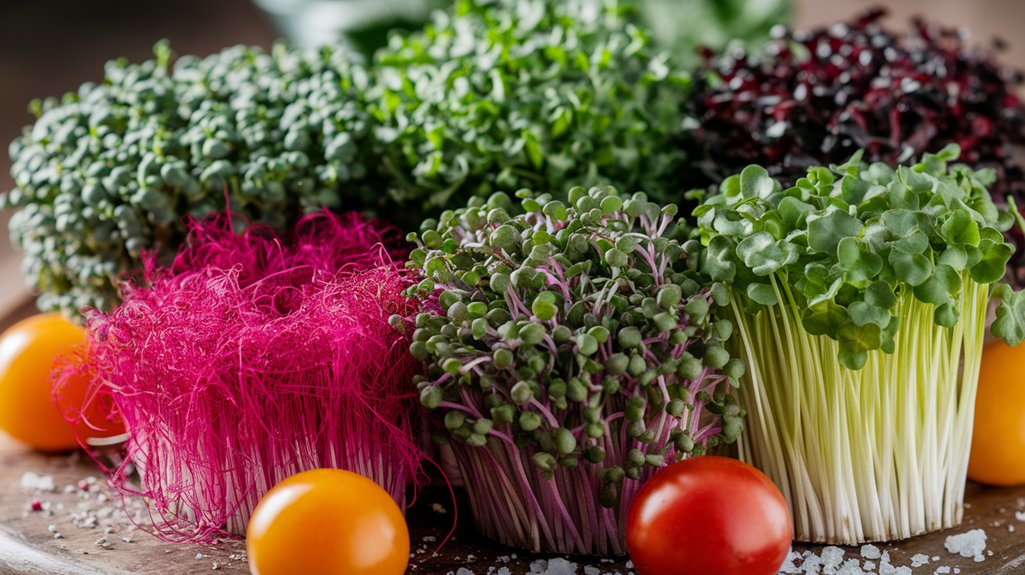
Microgreens aren’t just fun to grow; they also add a burst of flavor and nutrition to a variety of dishes.
I love tossing a handful of vibrant pea shoots into my salads for a sweet crunch, or sprinkling spicy radish microgreens over avocado toast to elevate its flavor profile. They’re perfect for garnishing soups, giving a fresh touch that tantalizes the taste buds.
When I’m preparing a sandwich, I often layer in some zesty arugula microgreens for a peppery kick.
Even in smoothies, a small handful of sunflower microgreens infuses a nutty essence.
These tiny greens are versatile, not just enhancing meals but also boosting their nutritional content.
Trust me, once you try them, you’ll be hooked!
Pairing Microgreens With Different Dishes
When I think about how to elevate my meals, pairing microgreens with different dishes always comes to mind. Their vibrant flavors can truly enhance salads, adding a fresh crunch that transforms simple greens into a gourmet experience.
Plus, when garnishing soups and stews, a sprinkle of microgreens not only adds visual appeal but also layers of taste that make every spoonful a delight.
Flavor Enhancements in Salads
Although salads often serve as a simple side dish, they can transform into vibrant culinary experiences with the right flavor enhancements.
One of my favorite ways to elevate a salad is by incorporating exotic microgreens. Here are four delightful pairings that can elevate your next salad:
- Pea Shoots: Their sweet, fresh flavor complements citrus dressings beautifully.
- Radish Greens: With a peppery kick, they add an exciting contrast to creamy dressings.
- Basil Microgreens: Their aromatic essence pairs perfectly with mozzarella and tomatoes.
- Amaranth Greens: These vibrant leaves bring a nutty flavor that enhances earthy ingredients.
Garnishing Soups and Stews
While I love a hearty soup or a comforting stew, I find that adding a sprinkle of exotic microgreens can truly elevate these dishes. Their vibrant colors and unique flavors not only enhance the visual appeal but also add depth to each bite. For instance, I often pair radish microgreens with spicy chili or sunflower microgreens with creamy potato soup.
Here’s a quick guide to help you choose the perfect microgreens for your next culinary creation:
| Microgreen | Best Pairing |
|---|---|
| Pea Shoots | Vegetable Soup |
| Basil Microgreens | Tomato Basil Stew |
| Mustard Greens | Beef and Barley Stew |
Experimenting with these pairings can transform your meals into a delightful taste adventure!
Incorporating Microgreens Into Your Diet
Incorporating microgreens into my diet has been a game-changer, bringing vibrant flavors and a nutritional boost to my meals.
These tiny powerhouses aren’t just a garnish; they’re a delicious addition to everyday dishes. Here’s how I do it:
- Salads: I toss a handful of microgreens like arugula or radish into my salads for extra crunch and zest.
- Smoothies: Adding a small handful of kale microgreens to my morning smoothie gives it a nutrient kick.
- Sandwiches: I layer microgreens like sunflower or pea shoots on sandwiches for a fresh, earthy flavor.
- Omelettes: Sprinkling microgreens into my omelette adds a burst of color and nutrients.
With each bite, I feel energized and excited about my meals!
Microgreens as a Garnish: Elevating Presentation
When I think about garnishing dishes, microgreens instantly come to mind for their vibrant colors and unique textures.
They not only enhance visual appeal but also elevate the flavor profile, adding a fresh, zesty touch.
Visual Appeal Enhancement
Microgreens can transform a simple dish into a visual masterpiece, capturing attention and delighting the palate. When I add these vibrant greens, I notice an immediate elevation in presentation.
Here are four reasons why microgreens make the perfect garnish:
- Color Variety: They come in a rainbow of hues, from deep purples to bright greens, enhancing visual contrast.
- Texture Contrast: Their delicate leaves provide a refreshing crunch, balancing the dish’s overall texture.
- Size: Tiny yet impactful, they fit seamlessly atop any plate, drawing the eye.
- Artistic Arrangement: I love experimenting with designs, creating an artistic flair that tells a story.
Incorporating microgreens not only beautifies my meals but also makes each dish feel special and thoughtfully prepared.
Flavor Profile Boost
While I’m plating my dishes, I often reach for microgreens not just for their visual appeal but for the incredible flavor boost they provide. These tiny greens pack a punch, transforming a simple meal into a culinary masterpiece.
Take, for instance, the peppery kick of arugula microgreens or the subtle sweetness of pea shoots; each brings a distinct taste that elevates the overall dish.
As I sprinkle them over soups, salads, or entrees, I find they create a delightful contrast with the other ingredients. Their fresh, vibrant flavors make every bite an adventure.
Plus, using microgreens as a garnish feels like adding a secret ingredient—one that enhances not just taste but also the dining experience, making it unforgettable.
Color Contrast Techniques
A vibrant sprinkle of microgreens can instantly transform a dish, creating a stunning visual contrast that grabs attention.
I love using them not only for their flavor but also for their ability to elevate presentation. Here are some color contrast techniques I often use:
- Pair with Bright Proteins: Use red amaranth microgreens against grilled salmon for a striking look.
- Contrast with Earthy Tones: Place spicy radish microgreens on creamy hummus for a burst of color.
- Highlight Seasonal Ingredients: Garnish a pumpkin soup with green basil microgreens to create a seasonal palette.
- Experiment with Textures: Layer smooth purées with crispy microgreens for an eye-catching contrast.
These techniques turn any dish into an artful experience that excites the palate!
Sourcing Exotic Microgreens
Finding the right sources for exotic microgreens can feel like a treasure hunt, but the rewards are worth the effort. I often start my quest at local farmers’ markets, where passionate growers showcase their vibrant varieties. It’s a joy to chat with them, discovering unique flavors like wasabi arugula or purple radish.
Online retailers also offer a stunning array, delivering exotic seeds straight to my door. I love exploring specialty grocery stores, too; they sometimes surprise me with rare finds.
Don’t overlook community-supported agriculture (CSA) programs either—they often include microgreens in their shares. Each source I explore opens new culinary possibilities, turning my dishes into flavorful adventures that excite my palate and inspire creativity in the kitchen.
Tips for Storing and Preserving Fresh Microgreens
When I bring home fresh microgreens, I want to make sure they stay vibrant and flavorful for as long as possible.
Proper storage is key, so I pay attention to the ideal conditions that help maintain their crispness.
Plus, I’ve discovered some great preservation methods that really extend their shelf life without sacrificing taste.
Ideal Storage Conditions
While many of us delight in the vibrant flavors and nutritional benefits of microgreens, understanding how to store them properly is crucial for maintaining their freshness and longevity.
I’ve found that following these ideal storage conditions can make a world of difference:
- Keep them cool: Store microgreens in the fridge at around 40°F (4°C) to preserve their crispness.
- Use breathable containers: A paper towel-lined container allows for airflow, preventing moisture buildup.
- Avoid washing until needed: Rinsing them before storage can lead to sogginess—wait until you’re ready to enjoy them.
- Separate varieties: Different microgreens have unique moisture needs, so it’s best to store them separately.
Best Preservation Methods
To ensure your microgreens stay fresh and flavorful for as long as possible, I’ve discovered several effective preservation methods that can make all the difference. First, always store them in a breathable container, like a paper bag, to prevent moisture buildup. You can also try wrapping your microgreens in a damp paper towel, placing them in a sealed container to maintain humidity.
Here’s a quick reference table:
| Method | Benefits |
|---|---|
| Breathable Container | Prevents moisture buildup |
| Damp Paper Towel | Maintains humidity |
| Refrigeration | Extends shelf life |
| Avoid Washing | Keeps nutrients intact |
Frequently Asked Questions
Are Exotic Microgreens Safe for Everyone to Eat?
I often wonder if exotic microgreens are safe for everyone to eat. Generally, they are, but it’s always wise to check for allergies or sensitivities.
I’ve enjoyed a variety of these tiny greens, and they can add a burst of flavor and nutrients to meals.
However, if you have specific health concerns or conditions, consulting with a healthcare professional is a good idea.
Enjoy them mindfully and savor their unique tastes!
How Long Do Microgreens Typically Last After Harvest?
Microgreens usually last about 7 to 14 days after harvest, depending on the type and storage conditions.
I’ve found that keeping them in a sealed container in the fridge helps maintain their freshness.
Some varieties, like arugula, tend to wilt faster, while others, like sunflower, can last longer.
It’s essential to check for any signs of spoilage, but when stored properly, they can still pack a flavorful punch well into that second week!
Can I Grow Microgreens Indoors Without Special Equipment?
Absolutely, I’ve grown microgreens indoors without any special equipment!
All I needed was a shallow tray, potting soil, and seeds. I placed the tray by a sunny window and kept the soil moist.
In just a week or two, I’d a vibrant crop ready to enjoy!
It’s incredibly rewarding to watch them grow, and you don’t need fancy gear—just some patience and care.
Give it a try; you won’t regret it!
What Tools Do I Need to Grow Microgreens at Home?
To grow microgreens at home, I’ve found a few essential tools make all the difference.
I use shallow trays for planting, a good potting mix, and seeds of my choice. A spray bottle helps me keep the soil moist.
If you want to get fancy, a grow light can boost growth, but natural sunlight works too.
With these simple tools, I can easily create my own vibrant, nutritious microgreens right in my kitchen!
How Do I Know When Microgreens Are Ready for Harvest?
I always know my microgreens are ready for harvest when they reach about 2 to 4 inches tall and have developed their first true leaves.
I carefully check the color and texture, looking for vibrant greens and a fresh, crisp feel. Typically, this takes around 7 to 21 days, depending on the variety.
When they look just right, I snip them just above the soil line for the best flavor and freshness!
Conclusion
As I’ve discovered the vibrant world of exotic microgreens, I can’t help but feel excited about the endless culinary possibilities they offer. These tiny powerhouses not only elevate flavors but also boost nutrition in our meals. Whether you’re growing them at home or sourcing them from local markets, incorporating microgreens into your diet adds a fresh twist to everyday dishes. So, why not embark on this taste adventure and explore the delightful potential of microgreens today?

